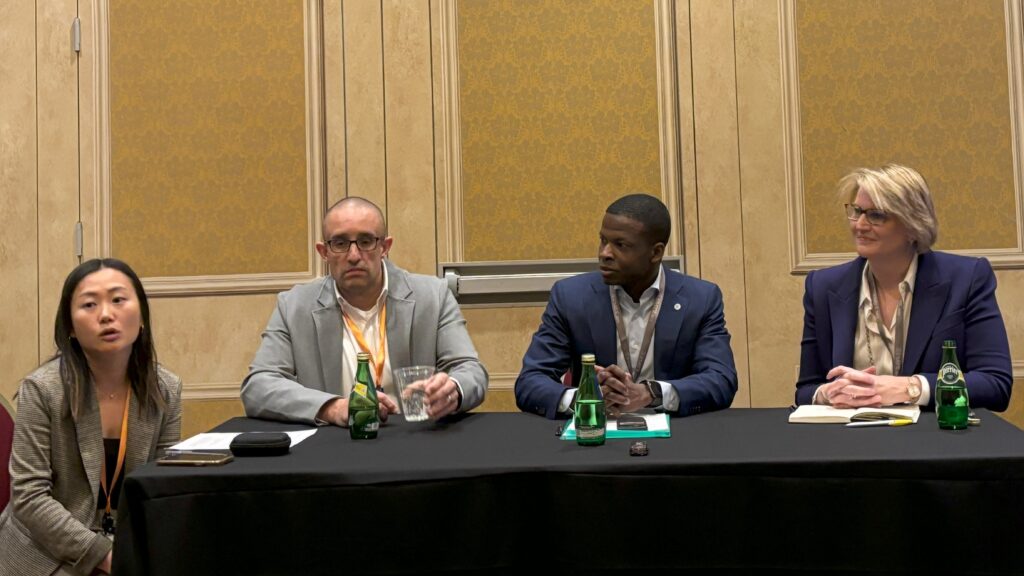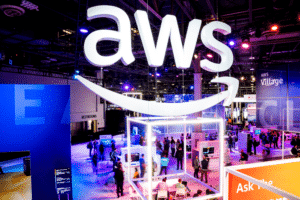Gen AI isn’t exactly a novel topic at the moment. Yet, according to reporting from Mercer, more than 75% of CHROs believe that technology and automation will become even more prevalent in the future. Leading organizations are already using and innovating with artificial intelligence tools, executing ahead of the curve for their workforce.
McKinsey & Company, Johnson Controls and Amazon Web Services (AWS) are among those committed to driving a future-focused workforce with these tools. At AWS re:Invent in Las Vegas this week, people leaders from these organizations described how they believe generative AI will impact—and is already changing—the future of work.
McKinsey & Company: A gen AI measurement phase

Katy George, who leads people functions for 45,000 colleagues at McKinsey & Company, sees generative AI as a tool that can significantly enhance productivity. Her firm is familiar with this topic through its work with governments, multinational organizations and global industry sectors.
McKinsey’s research suggests that 60-70% of tasks performed by humans at work today could be influenced by gen AI and automation. George highlights the potential for AI to streamline tasks for human resource teams, such as finding and retrieving information, leading to increased efficiency.
While the artificial intelligence buzz sometimes slants to the negative (ie, how many people will lose out when gen AI comes to town), George has seen high demand from employees who want to get started with new tools. After all, most people don’t want to spend time on boring, repetitive tasks.
She says her team and other HR leaders are pressed to keep up with demand and still protect proprietary information and employee information. McKinsey recently rolled out a new-gen AI assistant named Lily in an introductory capacity for some employees. Now in a “measurement phase,” McKinsey is clocking the queries and observing how the workforce uses the tool. George expects that it will connect networks of employees who eventually will teach others about the most exciting use cases.
“Gen AI allows us to quickly get up to speed,” said George. She knows that as more employees become “citizen developers,” these networks act as “virtual flywheels” to spread new ideas and adoption. “Rituals that we do today will be different in a few months as we continue to build gen AI into those rituals,” she said.
Johnson Controls: Align capabilities with expectations
Marlon Sullivan, the executive vice president and chief human resources officer at building technology and software company Johnson Controls, has seen a similar zest for tech adoption in his workplace, which has already implemented AI in many aspects of its operational capacities.
His HR team currently collaborates with generative AI to mine insights from employee surveys and craft job descriptions. His department has also launched a conversational AI virtual avatar to respond to questions previously answered by employees.
Johnson Controls has 100,000 employees across 70 countries, so Sullivan notes the evolving expectations people at his company have about gen AI. He cited research from Randstad demonstrating that employees desire faster career acceleration and promotions, and although they believe gen AI will help them achieve that, many lack the tools and opportunities to use the technology. Data indicates that only 13% of employees have been offered training on artificial intelligence topics and platforms.
But that doesn’t mean employees aren’t educating themselves. The growing gap between the have-learned and have-not-learned is a landscape for which HR teams should prepare. Sullivan emphasizes the need to align capabilities with expectations, particularly in performance management, where considerations extend to fairness and work practices. If generative AI indeed delivers the promised exponential increase in productivity, how will positive outcomes achieved with adept use of new tools be rewarded?
“There is a dichotomy between those who embrace and those who are hesitating,” said Sullivan. He believes in guardrails for the eager and risk-free opportunities for others, considering them crucial during this early phase of handling gen AI. Leveraging experimentation will help build a culture of responsible usage and illuminate unseen impacts on the future of work, according to Sullivan.
AWS: Democratize technology
Ian Wilson leads the people function for AWS, where there’s no shortage of partnerships between his colleagues and AI teams. His company has a tradition of setting up “playground” environments for newly developed tools so that a sampling of real users can handle the technology before it hits the mainstream. He says that at AWS, it is essential to support as many employees as possible with training and adopting new tools.
He emphasizes the need for a multi-disciplinary approach and intentional decision-making regarding gen AI technologies. Wilson, speaking in an “all-hands-on-deck and no-one-left-behind” style, says he finds value in democratizing technology with all the right safety scaffolds in place.
A former HR leader at Microsoft, Wilson views the current era of generative AI as continuing the tech industry’s legacy of building new tools to solve business problems. “It is such incredibly early days, not just one moment in time, [but] a journey that runs for a long time, potentially indefinitely,” he said.
Looking forward, he emphasizes the importance of intelligent augmentation, making processes more effective and efficient while acknowledging that creativity and ideation remain uniquely human.
It’s all about culture
All three leaders recognize the importance of creating a supportive environment for employees to embrace AI technologies, ensuring a minimum level of digital acumen for all. Meanwhile, people should be allowed to experiment.
“What happens when something doesn’t work out?” asked Wilson. Will there be penalties or rewards? Experiments, he suggests, should be translated into new opportunities.

This can be challenging for organizations that fear how employees will use generative AI, but proactivity is the way around this roadblock. At McKinsey & Company, George says it is critical to establish the right governance by including tech teams, the people function and legal and risk management units.
“Nothing is more important than getting ahead, as HR leaders, at the front with our colleagues, about how gen AI will impact work in our organization,” she said. This is the time to evaluate how gen AI adoption will help organizations apprentice colleagues in the future.
Johnson Controls has established an AI council, led by the organization’s CIO and CTO, and aiming beyond simple governance, Sullivan said. It is a cross-functional effort designed to reveal areas of empowerment and generate innovative ideas calibrated with risk abatement. Originally, this philosophy was leveraged for customer delivery, he said, but now it is also locked into how the company thinks about employees.
Wilson co-signs the multi-disciplinary approach, reminding HR leaders that generative AI is not a tech “procurement” effort. Successful teams will be intentional about which approaches are most “tunable” for their workforce needs.
Priorities for the future
Wilson says there won’t be a crisp line that designates we are now in a “post-gen AI world,” but many HR leaders are looking for footholds into the future. When asked what’s most exciting and important in the coming months, three areas stood out: skills-based talent, work evolution and cultural shifts.
Skills-based talent
George emphasized putting a premium on employees who express forward-looking skills rather than cling to historical patterns. She is concerned about bias toward what worked in the past. She told HRE she’s excited about skills-based talent and creating a framework less focused on degree acquisition and years of experience.
Her group is creating a skills taxonomy with the idea to produce certification programs. She’s ready to “open up the world of talent,” which she believes gen AI will accelerate.
Sullivan also sees gen AI as an opportunity to redefine talent development and implement skills-based talent acquisition. He said that business growth relies on new career and development paths, and gen AI will connect people and opportunities almost instantly. He calls this a “very, very powerful” talent space rich in opportunity.
Work evolution
Wilson believes that AI has the potential to make technology more personal, moving beyond the misconception that it is limited to “chatbots.” He says that HR leaders must embrace the concept that work is not evolving from something to something, but instead, it is a continuum. He said now is the time to replace fear with clear thinking to prove to each employee their contributions are relevant, even when augmented by gen AI.
“AWS is working intently on the most inclusive possible place to work,” said Wilson, who relies on hyper-personalization and taking more steps to see each individual as they authentically are.
Sullivan said something similar about elevating talent to grow the business rather than viewing tech as a way to cut down on one task to simply overload employees with another one. His company regards employee experience and listening as a way to not only drive engagement but also improve its stance as a high-performance culture.
Gen AI will help measure collaboration and use insights to help exceed business goals and support customers. Sullivan noted that his team is “testing the waters” with a few vendors to evaluate partners in this effort.
Cultural shifts
As these industry leaders grapple with the challenges and opportunities presented by the future of work, it’s evident that AI tools are not merely technological advancements but also represent a cultural shift that demands intentional leadership, innovation and a commitment to ethical and inclusive practices. Sullivan described the workforce of the future as built on three things: education, empowerment and encouragement.
As with any new tech, he advised, it’s best to fail fast, celebrate learning and ensure that those who adapt are rewarded. “Leveraging AI is table stakes,” he says. “And research shows that there are employees who expect to use it, so don’t lose a workforce that could make a difference.”

